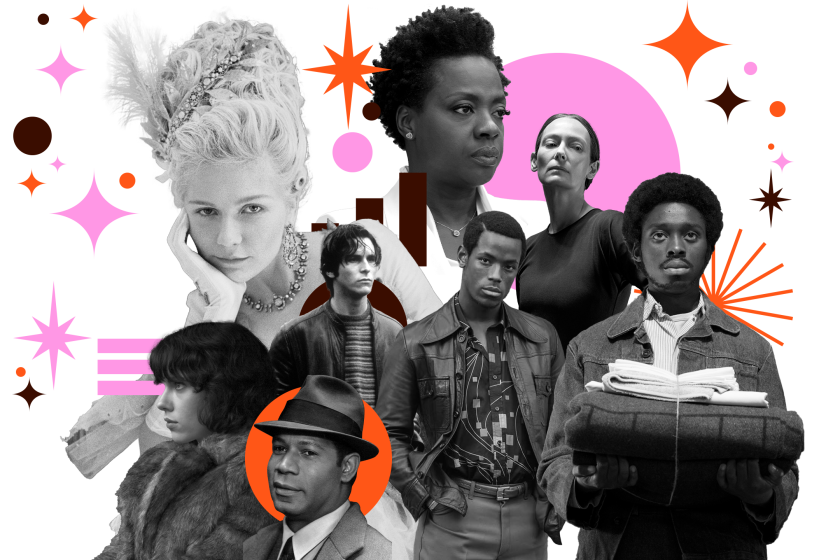
- Share via
Want proof of the old adage that timing is everything? Just ask film distributors.
At a moment when streaming has elevated TV in the cultural conversation and brought countless entertainment options to consumers’ fingertips, movies have faced a much cloudier picture — and the timing of their move from theaters to home video platforms, known as “windowing,” has never been more in flux.
Companies like Warner Bros. Discovery have changed their attitudes about the divide between the theatrical and streaming after a period of experimentation necessitated in part by the COVID-19 pandemic closing theaters. At CinemaCon in April, Chief Executive David Zaslav said, “We believe in full windowing of the motion pictures. We do not want to do direct-to-streaming movies.” This was a hearty reversal from the strategy when Warner Bros. was owned by AT&T and set out to put all of its movies on its streaming service at the same time as in theaters.
The challenge for theatrical movies is to get audiences in the door, to buy a ticket and enjoy the show. In the world of streaming, the idea is to add subscribers and retain them — to keep them coming back for more. The success of the former is measured by box office receipts and subsequent ancillary revenues, the latter by subscriber growth and Wall Street valuations.
The complete guide to home viewing
Get Screen Gab for everything about the TV shows and streaming movies everyone’s talking about.
You may occasionally receive promotional content from the Los Angeles Times.
“They’re in a different business,” said Michael Smith, professor of information technology and marketing at Carnegie Mellon University, on streaming platforms versus traditional theatrical distributors. Which means that movie distributors who need both theatrical and streaming revenues to make ends meet are faced with a complicated calculus.
“In a world where windowing has just kind of exploded, we’re really tailoring every release to the movie, to the audience and to where consumers are watching movies,” said Scott Shooman, president of IFC Films.
The company was among the first to release films to theaters and digital platforms at the same time, a practice referred to as “day-and-date.” With a portfolio of labels, including IFC Films, the genre-oriented Shudder and RLJE Films, Shooman explained that the company has plenty of options as to how a movie is released.
Although movies such as “The Lost King” or “Blackberry” have been given fairly traditional theatrical windows, for instance, the company can adjust as needed. The low-budget horror film “Skinamarink” saw its more-than-800-screen theatrical release pulled together quickly earlier this year after the movie became an online sensation before opening. Shortly thereafter it began streaming on Shudder and later went to other platforms.
“We’re uniquely set up to experiment and try things that no one else can try,” said Shooman. “That’s exciting to me as we’re looking at the consumer and being very strategic and observant of how consumer behavior is evolving and changing. I don’t think anyone knows how movies will look in a few months, but we want to be someone leading that charge and kind of redefining the rules as we did with day-and-date 15 years ago.”

All conversations about streaming inevitably turn to Netflix, which upended television with its all-episodes-at-once release strategy but has not had the same effect on movies. Netflix has warily ventured into giving movies limited theatrical releases prior to going on the platform — in Los Angeles that can often mean one week early at the Netflix-owned Bay Theater in Pacific Palisades — but in the main, the company has been notoriously reluctant to release its movies more widely in theaters.
“Netflix is an outlier because it never had a significant theatrical presence at its inception,” said Gene Del Vecchio, adjunct professor of marketing at the USC Marshall School of Business, “and it continues to be shy of theatrical releases because of the risk involved and the cost requirements of a significant marketing push. It’s simply not a business it is comfortable with.”
Ted Hope, veteran independent film producer who left his position as co-head of movies at Amazon Studios in 2020, said he often pushed for more robust theatrical releases even as the company was moving toward streaming-only releases.
Amid a writers’ strike largely about the power of platforms, we take a snapshot of the streaming pecking order, from Netflix to (formerly HBO) Max.
“It’s true, sometimes I think that when I said yes to the job offer from Amazon, what I was saying yes to was a front-row seat at the demise of everything I love,” Hope said. “But I defend myself. It could have gone in a different way, but it didn’t.”
Hope noted that when he was with Amazon, a number of the films they had success with, particularly “Manchester by the Sea” and “The Salesman,” which both won Oscars, were not acquired for worldwide rights, as is typical practice for many streaming platforms. (Rights to a given film, for streaming and theatrical, can be broken up territory by territory or sold off in an all-rights deal.)
Netflix recently acquired Todd Haynes’ “May December,” which premiered at the Cannes Film Festival, for only North American rights, possibly signaling a shift in strategy. And Amazon released the Ben Affleck-directed “Air” to theaters for nearly two full months before introducing it to their Prime Video streaming platform.

The most significant hurdle for streaming releases can be volume: It’s easy to get lost in the surge of other titles upon release, and potential viewers may have to dig deep to find a movie even when they are actively looking for it.
“The film disappears,” said Hope of what happens to many titles on streaming. “And the real truth about authored cinema is that it needs a long game. You need to keep it alive.” As he explains it, the milestones along the way of a traditionally windowed theatrical release each provide a moment where a film can gain notice.
“What the old method did was it built in a series of inciting marketing incidents that brought new audiences and resurrected the title,” said Hope. “So friends would say, ‘Oh my God, when my film played on an airplane I got a whole new series of emails from people.’ You talk to filmmakers now, and I think they recognize that the profit-based, single-title strategy brought with it that longevity. If your film doesn’t have those subsequent beats, people forget about you. On streaming it may be available to watch now, but no one’s going to be thinking about it.”
Film critic Justin Chang looks ahead to some of 2023’s most anticipated movies and offers his guide to immersing yourself in their directors’ past work.
Still, there’s no going back to “the old method,” at least not without adjustments.
“If you don’t observe what is happening in the transition in who’s going to movies, how they’re going to movies and where they’re consuming movies, it’s dangerous,” said Shooman.
“I think streaming has changed things, but what we want to make sure is that streaming is not a boon for mediocrity,” he added. “And that it could be a curated, specific experience where you’re really a purveyor of quality and consistency, which is hard. But I think people have to make decisions between not only what movie do I go and see on a Friday night, but who is giving me the most regular cadence of awesome s— to watch.”

Streaming platforms, many with deep pockets that can be hard to compete with, have also had a bracing impact on the acquisitions of films out of festivals such as Sundance or Cannes. For example, this year Apple TV+ picked up the Sundance musical drama “Flora and Son” for just under $20 million, having a few years earlier paid some $25 million for “CODA,” which would go on to win the Oscar for best picture.
“I never get upset when someone comes in and Apple or Netflix or whomever pays a lot of money for a movie,” said Shooman. “I think that’s money that hopefully is reinfused into the business. Where it gets a little delicate is that we’re in the single-picture business. Every time we buy a movie, we are figuring out the economics of how to get people to reach into their pocket and pay for that singular movie.
“And what I think streaming services do is they make content feel like something that’s not necessarily a single-picture commitment,” Shooman continued. “So there’s a disconnect between the value of a film or television show or album that comes with some of these streaming services that I think is just the evolution of how we think.”
Streamers like Netflix have become perennial Oscar and Emmy heavyweights. Inside the rule changes, technological advances and more that made it possible.
Plus, series and films, while competing more directly than ever for the viewer’s attention, also serve symbiotic roles in the ecosystem of a given streaming platform.
“While popular series will help gain and retain subscribers, dropping films into the streaming platform are used as marquee events a few times a year to solidify subscriber interest,” said Del Vecchio. “They work in tandem depending upon the needs that the studio has at any given time.”
If the pull of a good movie transcends where you watch it, however, distributors’ evolving approach to windowing has shown them that the theatrical experience, as a part of both the art form and the bottom line, is not going to go quietly.
“There’s something about streaming to me that feels very transactional and temporary and thus disposable,” said Hope. “What is the last streaming movie of a new release that I watched that I was really satisfied with?”
More to Read
The complete guide to home viewing
Get Screen Gab for everything about the TV shows and streaming movies everyone’s talking about.
You may occasionally receive promotional content from the Los Angeles Times.











